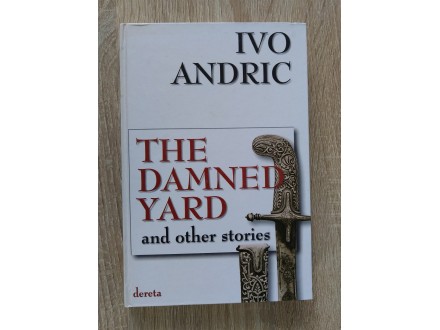THE DAMNED YARD and other stories Ivo Andrić,
| Cena: |
| Želi ovaj predmet: | 2 |
| Stanje: | Polovan bez oštećenja |
| Garancija: | Ne |
| Isporuka: | Pošta Post Express Lično preuzimanje |
| Plaćanje: | Tekući račun (pre slanja) Ostalo (pre slanja) Lično |
| Grad: |
Beograd-Dobanovci, Beograd-Surčin |
ISBN: Ostalo
Godina izdanja: 2003
Autor: Domaći
Jezik: Engleski
Ivo Andric - The damned yard and other stories
The novel is written in 1954. Ćamil, a wealthy young man of Smyrna living in the last years of the Ottoman Empire, is fascinated by the story of Džem, ill-fated brother of the Sultan Bajazet, who ruled Turkey in the fifteenth century. Ćamil, in his isolation, comes to believe that he is Džem, and that he shares his evil destiny: he is born to be a victim of the State. Because of his stories about Džem’s ambitions to overthrow his brother, Ćamil is arrested under suspicion of plotting against the Sultan. He is taken to a prison in Istanbul, where he tells his story, to Petar, a monk.
Out of these exotic materials, Andrić has constructed a book of great clarity, brevity and interest. No doubt it will be read by some as a political parable about the tyranny of the State, but also as a quite simply story about ill-fortune and human misunderstanding, fear and ignorance. Džem and Ćamil are doomed – and the certainty of their persecution is sometimes relieved, sometimes intensified by the stupidity and fright of the people who cross their ill-starred lives.
Construction takes up most of the book’s space: the central story of Džem as related by Ćamil lasts only a chapter or two. For the rest of the time the reader strips layer off layer, as one narrator passes him on the next. There is an interesting passage that helps to explain this method, at the moment when Ćamil starts narrating Džem’s story in the first person. “I” is a word, we are told, which fixes the position of the speaker in such a way that the exercise of will is no longer possible, and the speaker strength is exceeded – strength, presumably, to break out of the identification that all his past actions and thoughts force upon him when he uses the word. “I” is both a confession and an imprisonment. The fact that the novel passes the reader on from one narrator to the next rather suggests that the author is taking constant evasive action, lest he betray himself or his reader into the kind of “personal confession” which seals the fate of Ćamil. What exactly this game of form flirting with meaning signifies, must be left to the individual reader.
The movement is centripetal, towards Džem’s story, and then disperses. Details within the story are made to mimic this form. Thus when Peter receives the message telling him of his impending release:
“Two younger prisoners...were chasing around using him as the centerpoint of ever narrowing circles. Annoyed, he tried to break away from these exuberant youths when one of them brushed against him and he felt a folded scrap of paper thrust into his hand. The youths continued their chase but now in widening circles...”
The reader is led on just such a chase in the course of the novel. The effect of this is to make the plot seem more like a poetic image than an ordinary plot: capable, therefore, of as many meanings as are the images of an allusive poem. Yet the language is simple and direct, not at all “poetic”. The characters are remarkable alive, even in conversation. Karađoz, the governor of the goal, is a spidery authoritarian, who loves to torment the charges he loves. The prisoners “complained about the way one complains about one’s life and curses one’s destiny...it would have been hard for them to imagine life without him”.
“The Devil’s Yard” is justified, as all symbolic and figurative novels must be, by the extent to which it touches the emotions. It is extremely moving. Fear, horror, despair, amusement at times – all these indicate that the threat of the meaning has been recognized.
Izdavac : Dereta 2003, tvrdi povez, 220 strana
Jedan od najvećih romana srpske književnosti; Prokleta avlija - Ive Andrića u ovom izdanju, u odličnom prevodu na engleski jezik, okružen je najboljim pričama koje, čak i onim površnijim poznavaocima njegovog dela i srpske književnosti uopšte, daju potpuniju sliku o ovom piscu. Antologijske priče: Most na Žepi, Pismo iz 1920, Priča o Vezirovom slonu, Alipaša, Smrt u Sinanovoj Tekiji... i druge opisuju čitav opsesivni krug piščevih intresovanja, kako na književnom tako i na istorijskom planu. Možda je ovo najbolji izbor koji će čitaocima engleskog govornog područja, i drugih pogleda na južnoslovensku stvarnost, istorijske dubioze i traume, na najbolji način dati odgovore na pitanja; da li je Bosna zemlja mržnje (Pismo iz 1920.) i da li je čitav svet neka vrsta Proklete avlije.
c5
ili za dalje destinacije šaljem poštom kao preporučenu tiskovinu, paket ili post expres
Otkup knjiga i stripova
Predmet: 66875013











